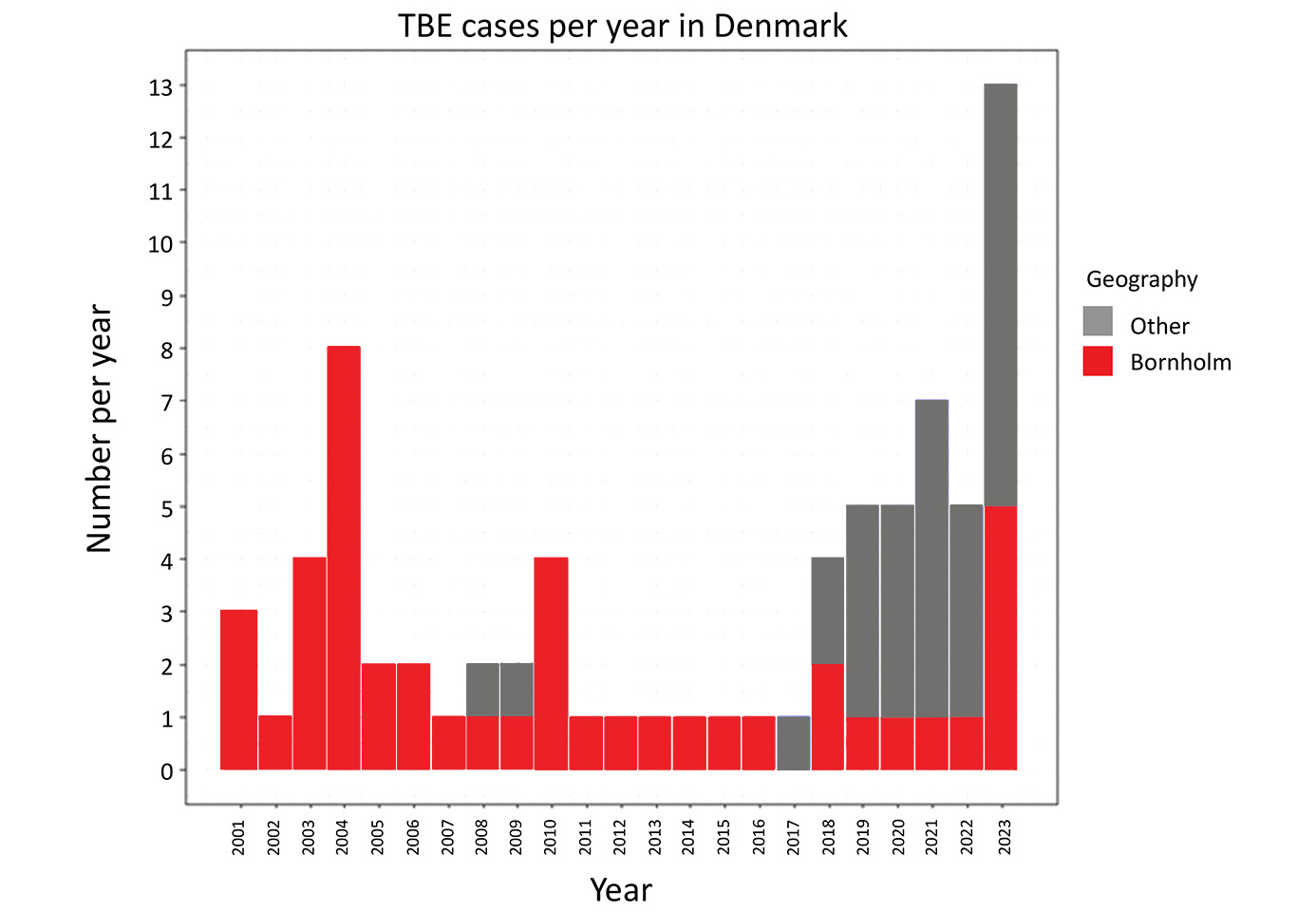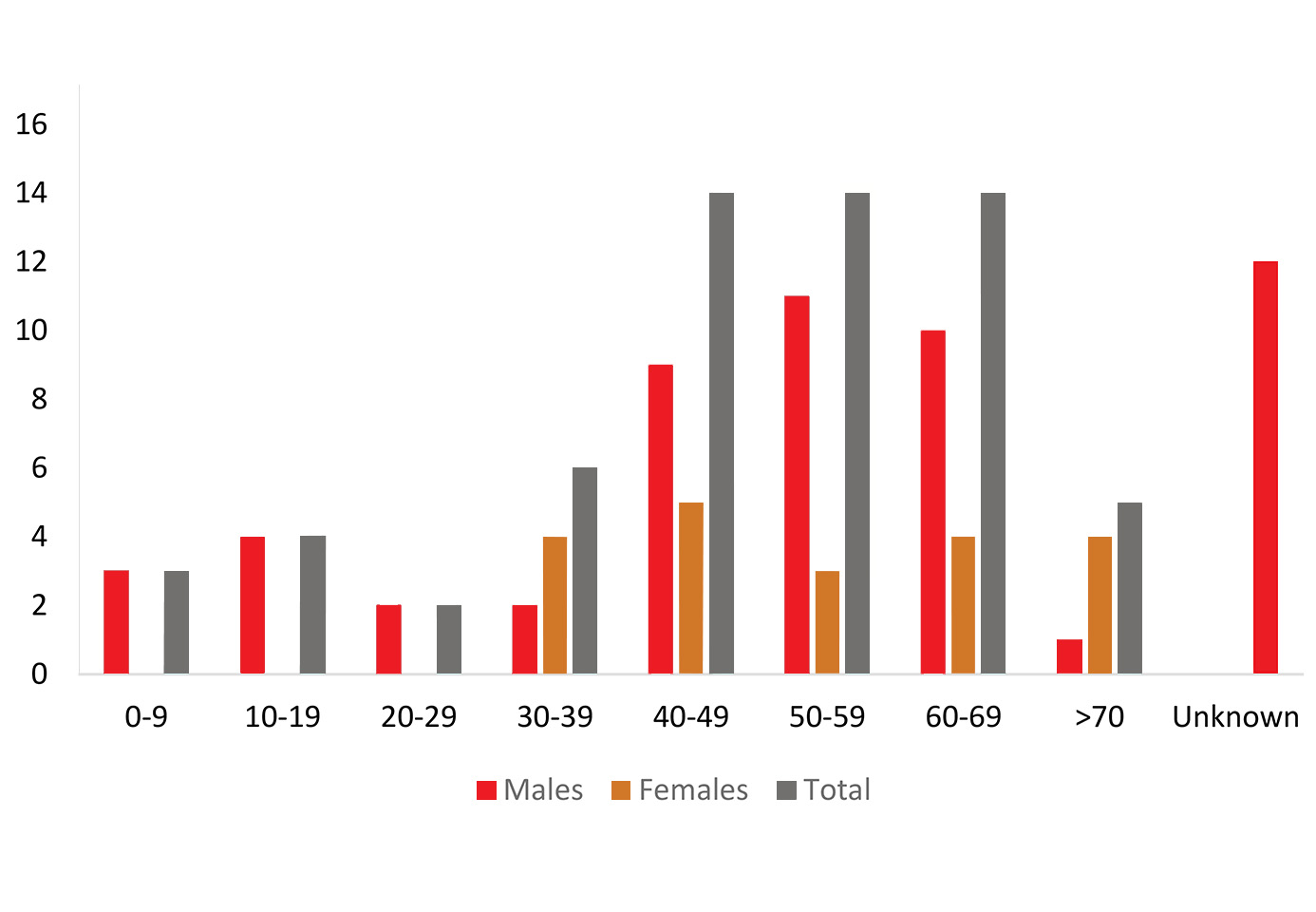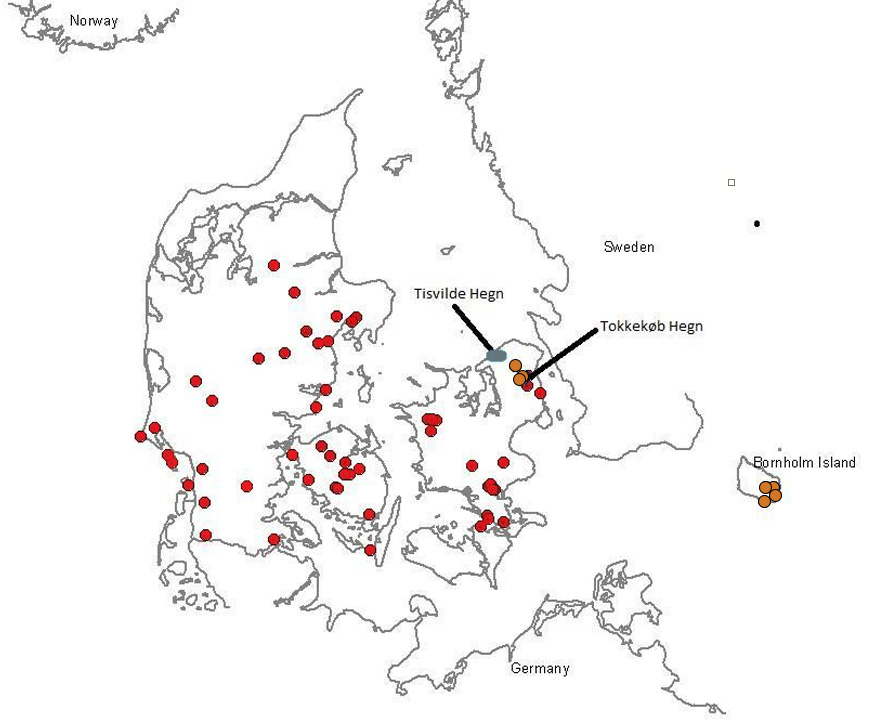Anders Fomsgaard
E-CDC risk status: endemic
(last edited: date 15.03.2024, data as of end 2023)
History and current situation
Since the 1950s tick-borne encephalitis (TBE) has been endemic in Denmark but only on the island of Bornholm. Bornholm is situated east of mainland Denmark, south of Sweden (Figure 3) and has a different fauna and flora from the rest of Denmark. Bornholm has about 45,000 inhabitants, but about 500,000 tourists visiting every year.
Freundt et al carried out a sero-survey during 1958- 19621 and found TBE antibodies in 1.4% of blood donors and 30% of woodworkers on Bornholm but no antibodies in subjects living in mainland Denmark. In 1963, Freundt found that 8 of 12 patients admitted to the hospital with acute meningoencephalitis of unknown etiology during 1951–1960 had antibodies to tick-borne encephalitis (TBEV).2 In 2000 TBE was re-discovered on Bornholm, where a retrospective study covering the period 1994–2002 (7 years) identified 14 TBE cases; 2 cases were tourists and 12 were inhabitants of Bornholm, giving an incidence of 3.81 per 100,000 inhabitants.3 At least 5 patients (37.7%) developed permanent sequelae. In addition, 32 forest workers on Bornholm were tested in 2000, and 20% had IgG antibodies but no symptoms. This is similar to the finding of Freundt in 1960. It was concluded that the data did not provide evidence of an increase in incidence of TBE. Ticks (Ixodes ricinus) from Bornholm were investigated for TBEV in 2000 and 2% were found to be infected.4 Since 2001 an average of 2.5 (range 1–8) TBE cases per year have been reported in Bornholm (Figure 1).
In 2009 we identified a TBEV microfocus (size app. 1000 m2) outside Bornholm in a forested area, Tokkekøb Hegn on Zealand just north of Copenhagen, which had two severe TBE cases reported, a forest worker in 2009 and a wood kindergarten teacher in 2008.5 Both subjects had a typical biphasic disease and TBE was diagnosed. Both experienced persistent neurological sequelae. TBEV European (Western) sub-type (TBEV-E) was identified in 2009 in I. ricinus tick adults and nymphs collected from this focus.5 In July and Sept. 2011 TBEV-Eu was again identified in adults and nymphs at the same Tokkekøb microfocus, and TBEV isolated (isolates T2 and T3)6, but in 2016 the Tokkekøb TBEV microfocus disappeared. The Tokkekøb TBEV WGS-sequence grouped with isolates from Sweden-Norway probably carried by infected ticks on migrating birds from Norway.
In contrast, one Bornholm TBEV from 2012 grouped into a different subclade from South and Central Bohemia.6 And an additional (2018) TBEV isolate from Bornholm (lake Rubinsøen) grouped with TBEV from Switzerland and Finland.7 TBEV was not identified in 58 tick pools collected 2010–2011 in North Zealand, Fuen, and Jutland by flagging or from roe deer. In addition, 78 patients in North Zealand with ‘summer flu’ after tick bites (July–Sept. 2010) and 96 hospitalized encephalitis patients after tick bites (2007–2009) who were negative for Borrelia all tested negative for TBE antibodies.6 This supports a limited TBEV introduction into the new temporary (2008-2016) microfocus in Tokkekøb.
In the hot summer in 2018 two sporadic and independent cases of TBE occurred outside Bornholm: probably somewhere in Jutland (north of Esbjerg) and on Fuen (near Faaborg), respectively.8
During June-July 2019 four independent TBE cases were suddenly hospitalized, infected in the same wood area Tisvilde Hegn in Northern Zealand, at the same specific wood playground (Figure 3). By flagging we identified a new TBEV micro-focus (1000 m2 in size) with a very high TBEV prevalence of 8% among the ticks (only in nymphs). Whole genome sequencing showed clustering with a TBEV from Norway probably from migrating birds.9 Later in 2019 three more clinical TBE cases appeared infected in the same wood Tisvilde Hegn but not at the playground microfocus. Since 2019 there have been 4-6 TBE cases yearly spreading from Tisvilde Hegn to more wood areas in Zealand including new areas in Tokkekøb Hegn, so far culminating in 2023 with 8 TBE cases (plus 5 cases on Bornholm). All cases reported here are autochthonous as confirmed by individual patient history. Another 13 Danish TBE patients were infected in our neighboring country Sweden during 2023.
Serological testing of roe deer ‘sentinels’ in 2002-2003 and again in 2013-2014 have suggested an increasing TBEV appearance in the whole of Denmark apparently with a delay in the appearance of also clinical TBE cases.10 Since ELISA antibodies to TBEV may cross-react to Louping ill virus (LIV) in roe deer, the presence of LIV outside of Bornholm and/or TBEV needs to be confirmed. Either TBEV and/or LIV are now widespread in Denmark.
| Table 1: TBE in Denmark | |
|---|---|
| Viral subtypes isolated | TBEV European subtype 5,6,7,9 |
| Reservoir animals | Roe deer 10 |
| Infected tick species (%) | 2% – 8% in hotspot 4,7,9 |
| Dairy product transmission | No |
| Case definition used by authorities | ECDC |
| Type of reporting | TBE has been a notifiable disease in Denmark (DK) since 2023 and SSI reports to ECDC (TESSy) |
| Other TBE-surveillance | Detection in ticks, seroprevalence in roe deer.10 Flagging from locations with more than one TBE case. |
| Special clinical features | Biphasic. Encephalitis, meningitis, meningo-radiculoneuritis3,5,8,9 |
| Licensed vaccines | TicoVac (Pfizer) and Encepur (Bavarian Nordic) |
| Vaccination recommendations | Regular movement in wood areas with TBE cases |
| Vaccine uptake | Unknown. In 2023 51,709 adult- and 16,713 pediatric TBE vaccine doses were sold in DK for an unknown number of persons. |
| National Reference center for TBE | Laboratory: Dept. Virus & Microbiological Special Diagnostic, Statens Serum Institut, 5 Artillerivej, DK2300 Copenhagen, Denmark. (www.ssi.dk) |
Figure 1: TBE case numbers over time
Note: Travel-related cases are excluded by individual patient history, all cases reported here are confirmed as autochthonous.
Click the image above to enlarge
| Year | Number of Cases | Incidence / 105 |
|---|---|---|
| 1994 | 2 | |
| 1995 | ||
| 1996 | ||
| 1997 | 2 | |
| 1998 | 3 | |
| 1999 | 4 | |
| 2000 | 3 | 3.81 |
| 2001 | 3 | |
| 2002 | 1 | |
| 2003 | 4 | |
| 2004 | 8 | |
| 2005 | 2 | |
| 2006 | 2 | |
| 2007 | 1 | |
| 2008 | 2 | |
| 2009 | 2 | |
| 2010 | 4 | |
| 2011 | 1 | |
| 2012 | 1 | |
| 2013 | 3 | |
| 2014 | 1 | |
| 2015 | 1 | |
| 2016 | 1 | |
| 2017 | 0 | |
| 2018 | 4 | |
| 2019 | 5 | |
| 2020 | 5 | |
| 2021 | 7 | |
| 2022 | 5 | |
| 2023 | 13 |
Figure 2: Age and gender distribution of TBE in Denmark, 2001 – 2023

Click the image above to enlarge
| Age groups (years) | Males | Females | All |
|---|---|---|---|
| 0-9 | 3 | 0 | 3 |
| 10-19 | 4 | 0 | 4 |
| 20-29 | 2 | 0 | 2 |
| 30-39 | 2 | 4 | 6 |
| 40-49 | 9 | 5 | 14 |
| 50-59 | 11 | 3 | 14 |
| 60-69 | 10 | 4 | 14 |
| >70 | 1 | 4 | 5 |
Figure 3: TBEV-isolation and TBE cases in Denmark7

Click the image above to enlarge
Isolate TBEV European (Western) subtype, T2; Tokkekøb Hegn, North Zealand7
Figure of Denmark showing endemic Bornholm and the TBEV microfocus Tokkekøb Hegn, North Zealand (TBEV isolate T2, 2011)6 and Tisvilde Hegn (2019)9; red dots indicate tick sampling from roe deer10, blue dots indicate flagging.6
Contact
Author
Citation
Fomsgaard A. TBE in Denmark. Chapter 13. In: Dobler G, Erber W, Bröker M, Schmitt HJ, eds. The TBE Book. 7th ed. Singapore: Global Health Press; 2024. doi:10.33442/26613980_13-9-7
References
- Freundt EA. The incidence of antibodies to the Russian Spring-Summer encephalitis complex and viruses in man and animals on Bornholm. Acta Pathol Microbiol Scand. 1962;Suppl.154:334-6.
- Freundt EA. Endemisk forekomst på Bornholm af Centraleuropæisk virus. Meningoencephalitis, overført af skovflåter. Ugeskrift for Læger. 1963;125:1098-104.
- Laursen K, Knudsen JD. Tick-borne encephalitis: a retrospective study of clinical cases in Bornholm, Denmark. Scand J Infect Dis. 2003;35:354-7. doi:10.1080/00365540310005305
- Kristiansen K, Rønne T, Bro-Jørgensen K. Tick-borne encephalitis på Bornholm. Copenhagen: Statens Serum Institut.EpiNyt. 2001; no. 17. ISSN 1396-8599.
- Fomsgaard A, Christiansen C, Bodker R. First identification of tick-borne encephalitis in Denmark outside of Bornholm, August 2009. Euro Surveill. 2009;14:19325.
- Fomsgaard A, Fertner ME, Essbauer S, et al. Tick-borne encephalitis virus, Zealand, Denmark, 2011. Emerg Infect Dis. 2013;19:1171-3. doi:10.3201/eid1907.130092
- Andersen NS, Bestehorn M, Lidia C-D, et al. Phylogenetic characterization of tick-borne encephalitis virus from Bornholm, Denmark. Ticks Tick Borne Dis. 2019;10(3):533-9. doi:10.1016/j.ttbdis.2018.12.008
- Laugesen NG, Stenør C. Tick-borne encephalitis-associated meningoradiculoneuritis acquired in the south-western part of Denmark. Ugeskr Laeger. 2019;181(27):V03190197.
- Agergaard CN, Rosenstierne MW, Bødker R, Rasmussen M, Andersen PHS, Fomsgaard A. New tick-borne encephalitis virus hot spot in Northern Zealand, Denmark, October 2019. Euro Surveill. 2019;24(43):1900639. doi:10.2807/1560-7917.ES.2019.24.43.1900639
- Andersen NS, Larsen SL, Olesec CR, Stiasny K, Kolmos HJ, Jensen PM, Skarphédinsson S. Continued expansion of tick-borne pathogens: Tick-borne encephalitis virus complex and Anaplasma phagocytophilum in Denmark. Ticks Tick Borne Dis. 2019;10:115–23. doi:10.1016/j.ttbdis.2018.09.007